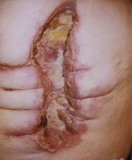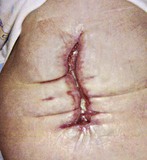Skill 45
Negative-Pressure Wound Therapy
Negative-pressure wound therapy (NPWT) is the application of a vacuum (negative pressure) to a wound through suction to draw edges of a wound together while providing a moist environment to promote healing and collect wound fluid (Figs. 45-1 and 45-2) (AHRQ, 2009; Campbell, Smith, and Smith, 2008; Netsch, 2011). The therapy is commonly used for dehisced wounds, diabetic foot ulcers, pressure ulcers, vascular ulcers (includes venous and arterial ulcers), burn wounds, surgical wounds (especially infected sternal wounds), and trauma-induced wounds (AHRQ, 2009; NPUAP-EPUAP, 2009; Petkar et al., 2011). The WOCN (2010) reports increased rates of healing associated with stage III and IV pressure ulcers when using NPWT.
Added benefits of NPWT include improved patient comfort and a reduction in the frequency of dressing changes. Contraindications to NPWT for chronic wounds are exposed vital organs, inadequately debrided wounds, untreated osteomyelitis or sepsis near a wound, untreated coagulopathy, necrotic tissue with eschar, and malignancy within a wound (AHRQ, 2009; Netsch, 2011).
A health care provider or wound care specialist orders the cycle and amount of negative pressure to a wound. There are different recommendations for the level of negative pressure to use for wound healing. Check your agency policy. The target negative pressures for wound healing tend to range from −50 to −175 mm Hg, but a setting of −125 mm Hg is most common (Netsch, 2011). The schedule for changing NPWT dressings varies based on the type and condition of wound.
Delegation Considerations
The skill of NPWT cannot be delegated to nursing assistive personnel (NAP). The nurse directs the NAP to:
▪ Use caution in positioning or turning patient to avoid tubing displacement.
▪ Report any change in integrity of the dressing to the nurse.
▪ Report any change in patient’s temperature or comfort level to the nurse.
Equipment
Stay updated, free articles. Join our Telegram channel

Full access? Get Clinical Tree




